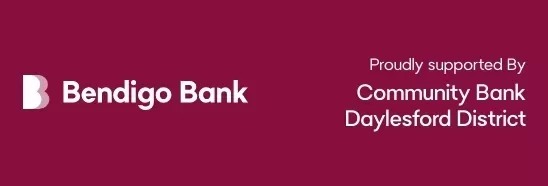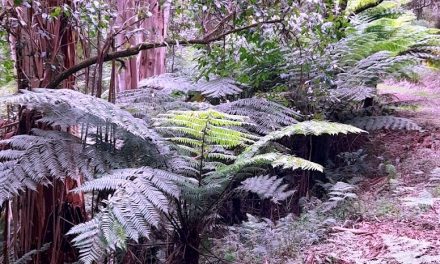Barry Golding
Jim Crow Creek is a 26km long ephemeral creek, draining 123 square km of country, formed by the confluence of Sailors Creek and Spring Creek at Breakneck Gorge in Hepburn Regional Park, two kilometres north-west of Hepburn. A streamside reserve near Franklinford shares the same name.
The creek flows in a northerly direction from steep, forested gullies to undulating grazing land and alluvial flats where it enters the Loddon River below the Guildford Plateau at Strangways, 8 km downstream of Guildford. As with other significant features in the local landscape, the river and creek had previous Dja Dja Wurrung names.
Our local traditional owners, the Dja Dja Wurrung Aboriginal Nation, have requested that the name, which they consider racist and offensive, be changed to reflect the traditional heritage and ownership of the land.
The Hepburn Shire is currently involved in a community consultation process, consistent with its Shire Reconciliation Action Plan, with a view to changing the creek name to one acceptable to the traditional owners. However, this process is not without controversy.
A number of local people query the traditional ownership of the land. Some locals were born along the creek or lived near the creek all their lives. They don’t want to change from the current name which they don’t acknowledge as racist or offensive. They do not believe that change is necessary or helpful and see it as their right to fight to retain what they understand as their heritage. The detailed process around the proposal to change the name recognises the rights of citizens to be heard.
I have written this brief account of the history of the name to help people understand the origins of the term and the way that Jim Crow Creek got its name.
‘Jim Crow’ was a widely used and racist, derogatory term used to describe black, mostly enslaved people in America in the 1830s.
The name ‘Jim Crow’ has origins in popular culture of the early 1800s. A popular and catchy song ‘Jump Jim Crow’, sung in the 1830s by a US white minstrel wearing black-face, negatively caricatured a clumsy, dim-witted slave. It became a huge hit with audiences worldwide.
The Jim Crow character in the song transferred to the now repealed ‘Jim Crow Laws’ that became part of several US state constitutions. The Jim Crow Laws, in place in the United States from 1877 to the 1950s, mandated the segregation of white and black people in public schools, public places, public transportation, toilets, restaurants and drinking fountains. Understandably, use of the term ‘Jim Crow’ is now very offensive in the US.
An English poem similarly adopted and disseminated the ‘Jim Crow’ theme to the British and colonial public from 1837. Called ‘The Jackdaw of Rheims’, it created a modern fable about how the crow (jackdaw) got its name ‘Jem Crow’. Again, the main character is a persecuted and dishevelled black crow.
‘Jim Crow’ was applied locally over the past 180 years. At times the creek, the district, the goldfield, the Aboriginal Protectorate, the ‘Tribe’ and individual Aboriginal people were called ‘Jim Crow’.
The name ‘Jim Crow’ was probably given to the mountain previously known as Lalgambook, now called Mount Franklin, by the squatter John Hepburn. Its crater and the areas around it were also called Larnebarramul (literally ‘nest of the Emu’). John Hepburn was a widely travelled international sea captain who had visited the US before arriving here. By 1840 he would have been well aware of the racist connotations associated with ‘Jim Crow’ and familiar with both the popular song and poem.
Even the so-called ‘protectors’ of Aborigines used the derogatory term. George Robinson, Chief Protector of Aborigines, in his diary entry of 14 February 1840, noted ‘… a hill Mr Hepburn calls Jem Crow … on account of the small hollows about it’. Edward Parker, the local Assistant Protector of Aborigines used the term ‘Jim Crow Hill’ when referring to the mountain in his 22 September 1839 report.
It was a custom for empires, their explorers, invaders and conquerors to bestow new names on geographical features. In Australia, it was a mistake not to ask the traditional owners what names were in place in the already settled, cultured and named landscape dubbed ‘Australia Felix’ by Major Mitchell in 1836. Some Europeans of the day noted traditional owner location names in their diaries or reports but those names were not generally used by settlers. Renaming the whole landscape compounded the arbitrary declaration of the convenient legal figment of terra nullius (empty land) over the whole continent. Using derogatory names is additionally insulting to traditional owners.
Several other communities, including in the UK, have had similar discussions about renaming landmarks and physical features once tagged as ‘Jim Crow’. The name of a former Mount Jim Crow National Park near Rockhampton in Queensland was legally restored to Baga National Park in 2018 in collaboration with the Darumbal Aboriginal people and the local community. There are other examples in Australia where similarly racist and offensive place names, such as ‘Nigger Creek’, have been officially expunged in consultation with the community and traditional owners as part of Indigenous reconciliation.
Dja Dja Wurrung names, when known, go back over a thousand generations. They seem a very good first choice for places we cherish in our landscape. Using them would be another small step towards local and national Indigenous reconciliation.
Barry Golding is a Kingston resident and an Emeritus Professor at Federation University. A longer and more detailed version of this history is available at Barry Golding’s website.
This article was first published in the June 2021 issue of the GDTA POST and is reproduced here with permission.














